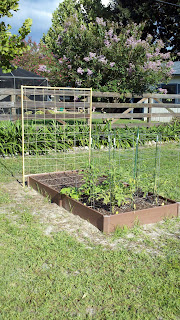Here are a few pictures of some of the pests and diseases that have plagued my garden. I have had as many caterpillars that there probably are in Southwest Florida and have really had a problem with the mosaic virus on my cucumbers, not to mention fungal diseases on the tomatoes as well.
I have learned to control most of the pickleworms, melonworms, cutworms and tomato hornworms with BT Thuricide. However, you really have to keep up on it on a weekly or even biweekly basis in order to keep them under control. What I've found is that an ounce of prevention is surely worth a pound of cure, and that you really need to be conscious of when you're planting your vegetables. In Southwest Florida timing is everything and if you do not time your crop correctly then you will be plagued by pests and disease.
For the most part I use insecticidal soap for control of aphids and some other soft bodied pests. Another method of control of aphids is simply take a hose and spray them off. I have found that ladybugs, although very beneficial in the garden, really are not effective in their overall control of aphids and other pests. But they sure do help out in the garden, and look beautiful too. Just be sure that whatever product you use, does not kill off the beneficial insects and bees. I've learned this the hard way, when after planting some pumpkins, they would just start to grow, but then would rot and fall off the vines. I could not figure this out, however I realized I was spraying for the melonworms (of course the wrong product) during the day, when the flower blooms were open, and the bees were active. What I was doing was killing off the bees, and not allowing full pollination! So there was the key to the puzzle. First, make sure your spraying when the flowers are closed, and bee activity is at a minimum. Second, make sure of what your spraying! And finally, investigate what pest you are wanting to control and the correct measures for that situation. During my pumpkin fiasco, I even reverted to using Seven dust, which of course did nothing but suffocate my leaves, and cause wilt, die off, and improper pollination, not to mention killing off my precious bees.
Another great method to use is spraying the plants with worm compost tea. I purchase this at my local farmers market along with worm castings That are a great source of beneficial compost for the garden soil.
In my garden I have a saying, all bees, butterflies, and spiders are welcome. Now I think I should add to that ladybugs!
Just some of the devastation in the garden, caused by three hornworms in just 2 days.
Like Waldo, Can you find the culprit? He wasn't easy to find at first, and took my husband and I several looks in order to catch them. Once found, they just jumped right out at you. Sneaky little devils aren't they
Tomato Hornworm. Ugly isn't he?
This is the telltale sign of the tomato hornworm. It's called manure, and usually found at the base of the plant. Almost looks like scat, but I found some on the leaves, so not scat.
Dreaded melonworm. The bane of my existence here in SW FL!!!

You can't really see it, but there are several holes in these squash, where the pickleworms have made their home.
Below are some picture of the black rot that affected my fall 2012 garden. B
lack rot - it is caused by a bacteria which is often seed borne but can survive on crop debris - control is use of certified seed, copper sprays can help reduce spread, also avoid working plants when wet and avoid overhead irrigation. Cut petioles should display black veins in petiole.
 |
| This is black rot on my broccoli and cabbage plants, it has even taken over the cauliflower as well. |
 |
| More of the devastating black rot. I at least harvested the main broccoli stalks prior to it getting this bad. |
This is damage from the Tomato fruit worm pictured below. They can become quite large, and LOVE the green tomatoes. I especially hate them because they don't seem to eat the entire tomato, just ruin them by taking bites out of them before moving to the insides. These again are controled by Thuricide or Dipel. I'm going to be giving Dipel Pro a try, as I am doing some further research on its advanced effectiveness.

I'm not really sure what this catepillar is, however he is doing just as much damage as all the other moth born pests. Any ideas as to his identity please give me a shout out. I at first thought he was a cutworm, but don't think so now. I've found him on the upper level of the tomatoes, in my green beans, on my cabbage, broccoli and bell peppers.
This is a picture of the Sri Lanka Weevil. He is new to SW Florida, and according to Ralph Mitchell -
Director/Horticulture Agent for the Charlotte County Cooperative Extension Service, there are no known pesticides for vegetable crops that can control them. They chew into the leaves, as you can see below, leaving a V shape to the leaf. One method of control is hand picking (which I have done and seems to work very well) or to take a black umbrella turn it upside down and place below the plant, and give the plant a little shake. The bugs fall off the plant very easily, and into the umbrella for you to dispose of. P.S. They are crunchy little buggers, and hard to squeeze in your hand so use gloves, or your fingernail to kill squish them. You can read further about this pest by going to :
http://charlotte.ifas.ufl.edu/horticulture/newsarticles/SriLankaWeevil.pdf from the Charlotte County Extention office.

















































